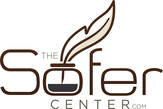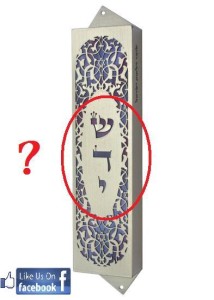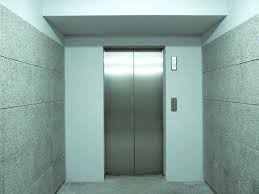|
In short $12
It may seem obvious to state, but not all Sofrim provide the same quality of work and give the Mezuzahs the same level of attentions. Some do a quicker job just the bare minimum. while others hold the Mezuzahs to a higher standard to ensure its Kosher status. For this reason alone it is important to realize that when looking for a Sofer to check your Mezuzahs you must shop for their reputation of quality work not their price. Being that a Sofer is being paid for their time. The cheaper the checking is more often then not an indication of a lower level of inspection, as less time is spent on each Mezuzah or someone less qualified is doing the checking, hence less cost. I have seen unfortunately in many a Sofer Stam employing young students who are only just beginning to learn Safrus to do the checking even before they have received their Kabolah. or just eyeballing the Mezuzahs in short minute or two. (a physical impossibility) to ensure its Kosher status. At the Sofer Center we spend 12-15 minutes per Mezuzah when checking, (not including time for rolling and putting back in the case.) We are not ok with your Mezuzahs just barley "passing" examination and we are highly qualified and certified. When we check we are looking for;
In most cases we can accommodate same day checking but depending on our availability it is best to call and schedule ahead of time.
4 Comments
Yes it does, however as far as a Brachah/Blessing is concerned it depends on the location of the garage. If it is adjoining or part of the house, such that one can exit the car and walk through a door into the house without leaving the garage all agree a Brachah/Blessing is recited. If however the garage is not adjoining or part of the house nor encircled by a gate that encompasses both it and the house it is a matter of dispute and therefore a Brachah should not be recited.
The reason is to demonstrate our love for this Mitzvah.
There is a source to this custom in the Talmud regarding the conversion of the Roman Caesar’s men (Avodah Zarah 11b). Onkelos the son of Klonimus converted to Judaism. The Caesar, his uncle sent a legion of Roman soldiers to retrieve him. However, he enticed them to Judaism by quoting verses, and they converted to Judaism.The Caesar sent a new legion but this time he instructed them not to enter into conversation with his nephew. As they dragged him from his home, Onkelos saw the Mezuzah affixed to his doorpost. He placed his hand upon it to kiss it and asked them, “Do you know what this is?” The soldiers could not contain their curiosity and answered, “You tell us” Onkelos explained to them, “It is the custom of the world that the king sits in the inside of the palace, and the guards protect him from the outside. However, with G‑d, His servants are inside their homes and He protects them from the outside, as the verse says (Psalms 121:8), “G‑d will protect your departure and your arrival from now and forever. They were inspired and they too converted to Judaism. After that, the Caesar ceased sending soldiers to bring him back. A right-handed person should use his right hand and a left-handed person should use their left hand. It is permitted to kiss the Mezuzah even before one has washed his or her hands in the Morning since the Mezuzah is covered in a case. If a Mezuzah has fallen down on to the ground and it is still in its case one should give charity. If it is not in its case (if the case breaks from the fall or it falls while it is being inserted into its case) it is questionable whether one is required to fast as in the case of Tefillin. In this case, one should as least give charity.
It is written in Seforim that if a Mezuzah falls down it is customary to have it checked before it is reaffixed. If one does not have plans to get the Mezuzah checked, it must be reaffixed immediately (even before putting on Tefillin or davening) with a Brachah if its a location that requires a Brachah. If however, it cannot be reaffixed immediately, for example if it falls off on Shabbos/Shabbat, you may continue to use the room. The Mezuzah should be picked up in an irregular manner, i.e. with a spoon and put aside in order to be put up right after Shabbos. Practically speaking, before you put it back up you should check that it was attached properly, such as with screws, nails or double-sided mounting tape. If it wasn’t make sure it is re-affixed properly. 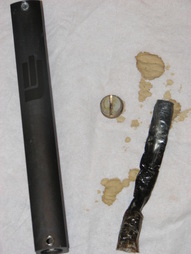 Water-logged Mezuzah Water-logged Mezuzah Note: The word Mezuzah always refers to the scroll, and the case or cover is always referred to as such. Even if your Mezuzah is written properly and according to Halacha, being that it is a very delicate item it needs to be treated gently and cared for properly. It may seem obvious, but many people are unaware of the issues at hand. Every Mezuzah should be wrapped in a protective wrapping before it is placed in a case. Wax paper, parchment paper, Saran Wrap holds moisture in, which may cause damage to the Mezuzah as well it melts in very hot temperatures onto and ruin the Mezuzah. A Mezuzah case that does not necessitate the Mezuzah to be rolled tightly is best. This will place less stress on the letters and help prevent the ink from cracking. Also, when there is sufficient space inside there will be less chance of the Mezuzah tearing or crumpling when it is put in and taken out. Never force a Mezuzah into its case if it does not get ruined going in there is a big chance it will be stuck in and get ruined coming out. Outdoor Mezuzos A Mezuzah affixed outdoors must be placed in a sealed plastic Water proof Mezuzah cover or a specially treated wood case which opens only from the bottom with a plug or screw. A water proof cover is a solid piece of plastic with only one opening on the bottom and it is sealed airtight with a rubber cork. This will help prevent rain from seeping in. Care should be taken to prevent water from being directed toward the case from the bottom, for example with a sprinkler. If a Mezuzah will be in direct sunlight, use a solid white or silver-colored case in order to reflect the light. Clear plastic cases are not recommended for use in direct sunlight, as the Mezuzah may get burn spots or dry out and crack[ Dark-colored cases will get very hot and may damage the Mezuzah. As well it is important to avoid metal covers, the reason for this is two fold 1) The Das Kedoshim writes as follows; The reward for fulfilling the Mitzvah of Mezuzah is long life as the Posuk says “Leman Yirbu Yimeichem” and weapons of war are made from Barzel – Metal therefore it’s not proper to put a Mezuzah in a material that cuts life short. 2) Metal tends to absorb the temperature much more than plastic, in the winter it becomes ice-cold and in the summer it gets scolding hot,which is very damaging for a Mezuzah. (think about it would you touch a metal railing during the winter months without gloves? or a metal railing in the heat of a summer day? I think not! ) Convenience in Affixing Mezuzos Fragile Mezuzah cases, such as those made from silver, glass, ceramics and Polymer clay must be affixed with extreme care. If they are not affixed gently they may crack or break. Be sure not to tighten the screws or nails tightly as the pressure can also cause damage. It is advisable to use screws, rather than nails, to affix a Mezuzah because it will be easier to take down later and there is less risk of causing damage to the case and the door frame when removing nails. Double-sided foam tape may be used to affix a Mezuzah case as long as the case does not have a removable back. This is an excellent option if you do not want to make holes in the door frame or will have difficulty making holes. Cellophane or masking tape should preferably not be used if the case will not be firmly affixed. Many people dread removing and re-affixing their Mezuzos when it is time to have them checked. To avoid this feeling it is suggested to use cases which unscrew or unplug from the top or bottom. With these cases one only needs to remove the plug and possibly one screw to remove and reinsert the Mezuzah. If a Mezuzah is stuck inside its case, carefully bang the case against another object to loosen it. Alternatively, you can remove the Mezuzah by grasping the very bottom of it with a blunt tweezers, taking care not to damage the lettering. In order to be certain that the Sha-dai remains facing forward inside an opaque case, the Mezuzah should be rolled loosely enough so that it cannot rotate but tightly enough for it to be easily removed. Alternatively, it can be taped into place. If you use a clear case or one with a window for the Sha-dai, you will always be able to see if it is facing forward. Some Mezuzah cases are made of a clear glass or plastic tube resting in a wood or metal base. The tube of this type of case often turns, causing the Sha-dai to shift this is a proplem Simply twist it back into place as necessary and tape the back of the tume to post When cleaning a Mezuzah’s outer case it can be lightly dusted. But never use liquid cleaners because they may seep within the case and damage the parchment scroll. The Kitzur Shulchan Aruch states that Mezuzos and Tefillin should optimally be checked on a yearly basis. If that is not possible then Mezuzos must be checked at least every three and a half years. By checking your Meuzuzos regularly you will prevent serious problems from occurring as well as a potential big expense of having to replace your Mezuzos. If the letters start to grey or if the letters and crowns begin to form a small crack and break this will cause the Mezuzah to become not Kosher, if caught in time it can be fixed, however if it goes years without attention chances are it will be too late the breaks will be to big to be able to fixed and it will have to be replaced. As well unfortunately there are Mezuzos that were Not Kosher from the get go, and the more times they are checked the more chances you have to finding the problems.
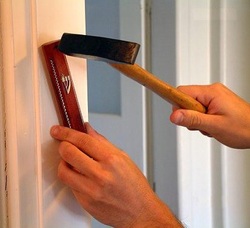 When Removing Mezuzos for Checking the old nails, screws and tape previously used to affix the Mezuzos may be discarded. However, Mezuzah cases and Mezuzah wrappings if no longer needed should be treated as sacred material and require genizah/interment, after their use. It is preferred to have all of the mezuzahs returned to their original doorposts, or at least to the same type of entrance way (i.e., from one bedroom door to another, or from one archway to another) in order that you don’t lower the status of a Mezuzah that was once on a door required Midoraisa (Biblical) to a entrance way that is only Rabbinical. A practical suggestion: when removing the mezuzahs, label each mezuzah case with a number (using masking tape or the like). Tape an identical number on the doorpost from which it was removed. When the mezuzahs are remounted, match the numbers from your cases to the numbers on the doorposts. When removing Mezuzos for Checking, or renovations are being done, or for any other reason when the Mezuzah is remounted, the blessing should be recited only if the Mezuzah was off the doorposts for at least one night. If you are also adding new Mezuzahs at this time, it is preferable to recite the blessing on a new one (providing that it is mounted on a door that requires a blessing). 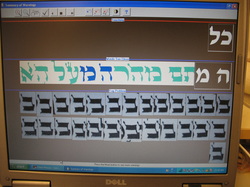 Computer checkingIn addition to a Sofers examination, we strongly recommended you to have a computer checking done as well. Although examiners do the best they can, humans can make mistakes which the computer can catch. However, it is not a substitute for the manual examination, for although the computer can successfully catch missing and substituted letters, it can not determine letters with a problematic shape if they are Kosher or not, or do the actual repairs if necessary. This can only be accomplished through a meticulous manual examination by a qualified Sofer. The cost for a computer examination is minimal and a one time expense. If you have never had your Teffilin or Mezuzos computer checked, it is advisable to do so the next time you have them examined. 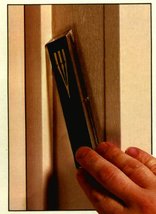 The Kitzur Shulchan Aruch states that Mezuzos and Tefillin should optimally be checked on a yearly basis. If that is not possible then Mezuzos must be checked at least every three and a half years. Tefillin, However, have no mandatory time frame for checking. Rather they should be checked based on how they are handled, how often they are used, and atmospheric condition. As such. it is a good idea to inspect your Tefillin boxes and straps from time to tome to ensure that they are Kosher. If you have any doubts or concerns, or if you have a reason to suspect something is amiss, they you should have your Mezuzos and Tefillin checked right away. By checking your Meuzuzos regularly you will prevent serious problems from occurring as well as a potential big expense of having to replace your Mezuzos. If the letters start to grey or if the letters and crowns begin to form a small crack and break this will cause the Mezuzah to become not Kosher, if caught in time it can be fixed, however if it goes years without attention chances are it will be too late the breaks will be to big to be able to fixed and it will have to be replaced. As well unfortunately there are Mezuzos and Tefillin that were Not Kosher from the get go, and when a Sofer Checks Mezuzos or Tefillin there are many potential problems he is looking out for, such as: Letters, Words or/and Tagim that are Missing, Extra, Substituted, Touching, Broken. Improperly Spaced, Deformed. Faded, Cracked and weather damaged. As you can imagine that is a a lot to focus on while checking a Mezuzah or Tefillin. Very often when a Mezuzah has a lot of one particular problem such as problematic spacing the Sofer will be giving most of his attention to fixing the problematic spacing and not be giving 100% to other areas such as missing or added letters... Therefore the more often a Meuzah or Tefillin is checked the greater the chance all problems if any will be discovered. |
Categories
All
AuthorRabbi Kass was ordained by Rabbi Yisrael Meir Lau, former Ashkenazik Chief Rabbi of Israel. He is certified as a Sofer for both Kesivah and Hagoah by one of the leading experts in Safrus, Rabbi Avrohom Tzvi Vosner, Rav of the Vad Mishmeres Sta”m. Archives
March 2018
|
What our clients say about us: |
To enhance our service quality, we operate on an appointment-only basis.
Please contact us to make an appointment. $12.99 Flat rate shipping! Mezuzahs, Tefillin & Accessories! |
|
